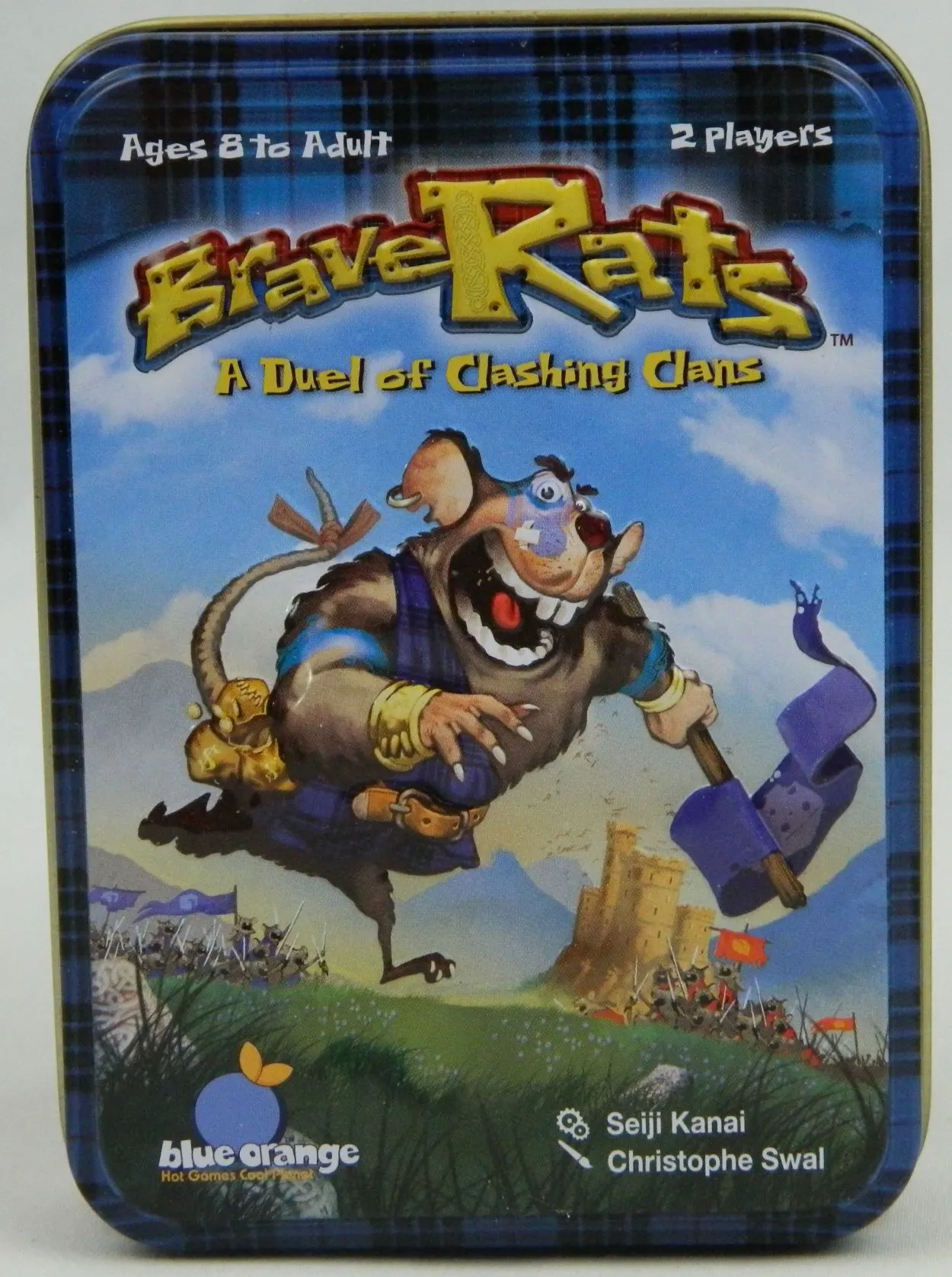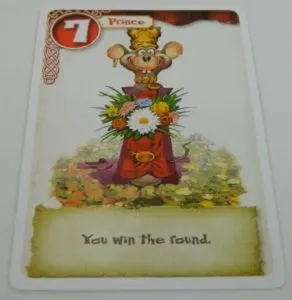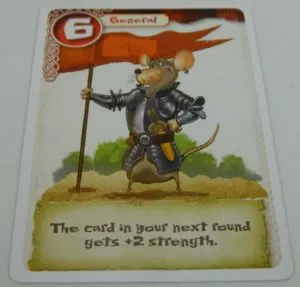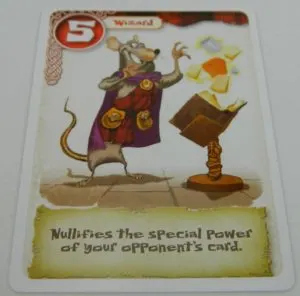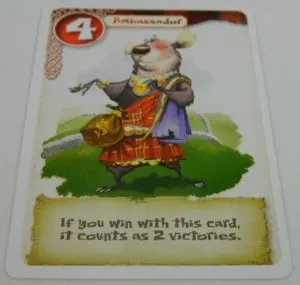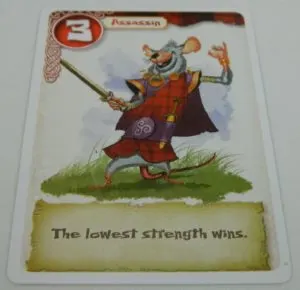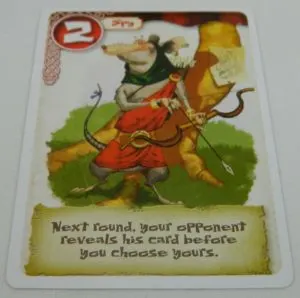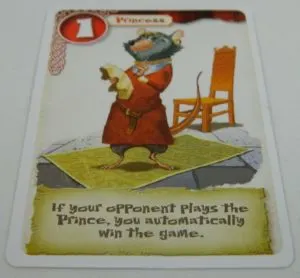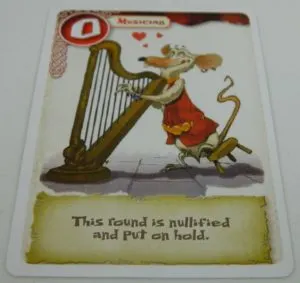When most board game fans hear of the name of Seji Kanai, the game that immediately comes to their mind is the game Love Letter. Love Letter was a unique game as it showed that you could actually make a pretty compelling game with just a deck of sixteen cards. While Love Letter isn’t perfect, I generally liked it as it had some really interesting ideas. I bring this up because today I am looking at Brave Rats which just so happens to be the game Seji Kanai released the year before Love Letter came out. Just looking at the game’s rules I could tell that the game had a very similar feel to Love Letter where you could maybe even say that it inspired Love Letter in a way. Because of this I was intrigued to check it out. Despite being a small game of only 16 cards, Brave Rats is a fun little game that fans of simple card games should enjoy.
How to Play Brave Rats
Setup
- Separate the cards by their color and give one set to each player.
Playing the Game
Brave Rats is played over a number of rounds.
For each round the players will choose one of the cards from their hand and will place it face down on the table. When both players have chosen their card, both cards will be revealed at the same time. The players will then resolve both cards to determine who won the round. Typically the card with the greater strength will win, but the played card’s effects may change this (see below).
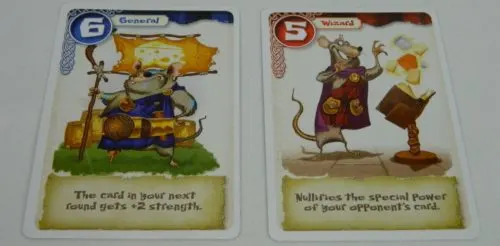
For this round the blue player played the General and the red player played the Wizard. As neither character’s ability impact the outcome of this round, the blue player will win the round as their card’s value of six beats the other player’s five.
Whichever player’s card won the round will be kept face up on the table to show that the player won the round. The other played card will be turned face down. If the players tie, the current round will be put on hold. The two tied cards will be set aside and the winner of the next round will receive the rewards for winning both rounds.
The Cards
Each card in the game has a number in the top left corner. This is the cards strength. Along the bottom of the card there will also be some text which details the cards special ability which activates when it is played.
Prince
The Prince card will win any round except if the other player plays the Princess or Musician. The Assassin’s ability does not apply to the Prince.
If the other player plays the Princess when you play the Prince, they will automatically win the entire game.
General
The General will give +2 strength to the card that you play in the next round. If the other player plays their Wizard in the next round, it will not affect this +2 strength.
Wizard
The Wizard card nullifies the ability of the card played by the other player. Thus whichever card has the higher strength will win the round.
Ambassador
If a player wins a round with the Ambassador it will count as two wins. If an Ambassador is put on hold (the round that it was played in was a tie) it maintains this ability if the player who played it should win the next round (winning the round will count as three wins).
Assassin
When this card is played, the card with the lower strength will win the round.
Spy
In the next round the other player has to reveal the card that they are going to play before you have to choose your card. If both players play the Spy in the same round, the two cancel each other out.
Princess
If the other player plays their Prince in the same round that you play the Princess, you will automatically win the game.
Musician
When a Musician is played it will nullify the current round and put it on hold (treated the same as if the players tied). The Musician’s ability takes preference over all other abilities except for the Wizard’s.
End of Game
The game ends when one player has won four or more rounds. This player has won the game.
If neither player reaches four wins before they run out of cards, the game ends in a tie and another game is played.
Variations
Traitor – Before the game each player will randomly take a card from the other player’s deck.
Lucky Draw – Each player will shuffle their cards to create a draw deck. Players will maintain a hand of three cards which they will choose which card to play from. When a card is played, a new card is drawn.
Fast Rat – A player will win the game after winning three rounds.
Draft – Shuffle all 16 cards together. Four cards are drawn. One player will look at the four cards and choose one to keep. The cards are then passed to the other player who will pick one. This is continued until all four cards are chosen. The next four cards are then drawn with the other player getting to choose the first card. This continues until all 16 cards have been given out.
Random Deal – Shuffle the 16 cards and randomly deal eight cards to each player.
Princess Attack – One player will give their Princess to the other player in exchange for their Prince. Thus one player has both Princes and one has both Princesses.
The Emperor – Play three games. The first to win two games wins the game.
My Thoughts on Brave Rats
With how much I enjoyed Love Letter, I was intrigued to play Brave Rats. Based on Seiji Kanai’s tendency to create simple streamlined games I was expecting a pretty straight to the point game with Brave Rats. The game didn’t disappoint in this area. The game only consists of sixteen cards spread between the two players. Each round both players will choose one of their cards to play with the higher powered card winning the round. In a way this aspect of the game reminded me of the classic card game War except that you actually get to choose what cards you wanted to play on your turn.
If this was all there was to the game, it would honestly be kind of lame. It would become a complete guessing game of trying to guess what card your opponent was going to play and then choose a higher card yourself. Thankfully there is more to the game than this. Each card has its own special ability attached to it which makes things considerably more interesting. Thus every card has its own purpose where it would be best to play it. A card may have a low strength value, but its special ability could work really well against other specific cards. In a way this mechanic is similar to how each of the cards in Love Letter have their abilities which make them useful in their own ways.
I enjoyed this mechanic of each card having its own unique ability in Love Letter and the same holds true for Brave Rats. With each player only getting eight cards in the game, each had to have its own value and time when it can help you win a round. I think the game does a good job differentiating the special abilities so it feels like each card has its own purpose. Some cards directly target another card such as the Princess automatically winning you the game if it is played against the Prince. Other cards manipulate how the cards are compared such as the Assassin which lets the less powerful card win. Others nullify special abilities or even put the whole round on hold.
For these type of games to work the abilities on the cards have to make you feel like you can use them in interesting ways in order to manipulate the game in your favor. Brave Rats succeeds in this area as the different powers are interesting and work well for the most part. There were cards that I thought were more useful than others mostly due to how I play these type of games, but each has their own purpose. For example the Princess pretty much loses every battle unless the other player plays their Assassin. They have the ability to automatically win the game for you though if you choose the absolute right time to play them. The cards are balanced pretty well where all of them can win rounds in their own way. For a game whose deck only has eight cards, these abilities add a decent amount of strategy to the game. The game succeeds in making you feel good when you play a card perfectly to counter another player’s move which they thought would win them the round. In a way Brave Rats kind of feels like what you would get if you took the card game War and actually added some strategy and modern game mechanics to it.
With such a simple concept it should come as no surprise that the game is really easy to play. Basically you just choose a card to play on your turn and then compare it to the card that the other player played. You could probably teach the game to a new player within a minute or two. Honestly the only somewhat difficult element of the game comes from the special abilities found on the cards. This isn’t even that difficult as most of the abilities are quite straightforward. There are a couple of cases where two card abilities contradict one another where you might have to consult the rules, but otherwise these abilities shouldn’t be hard to get a hang of. A new player might need a game to fully grasp what they are supposed to do, but after that I see no real issues with playing the game. The game has an age recommendation of 8+ which seems about right.
While I enjoyed Brave Rats, at the end of the day the gameplay basically boils down to guessing what the other player is going to play. As both players have the exact same deck (unless you play one of the variants) you should be able to remember the cards that the other player hasn’t played yet. As you get further in the game it does become a little easier to guess what the other player will do. In the early rounds though it is a complete guess as to what the other player is going to do. If you know how the other player plays games it may help you make an educated guess, but outside of reading the other player there isn’t a whole lot that you can do other than hope you guess well. Ultimately the player that is better at predicting what the other player does will likely win the game. Because of this fact the game does depend on quite a bit of luck. You can make bad decisions which will make it harder to win, but you basically need some luck on your side if you want to win. This is the game’s biggest issue by far.
The one thing that prevents this from being as big of an issue that it could have been is the game’s length. A lot of board games claim that they can be finished in just a couple of minutes. Usually this ends up with the game taking quite a bit longer than the expectation. In the case of Brave Rats the claim that games only take five minutes actually seems spot on. In fact a lot of games may take even less time. Unless players take way too long deciding what card to play, the games can’t take that long as each game will only take at max eight rounds. This does a good job offsetting the fact that you need luck on your side as each game is so short that you can easily just play another game and hope your luck is better. This also makes the game a great filler game and would even work well as a travel game.
I began this review by comparing the game to Love Letter so I might as well directly compare the two games. I don’t know the background behind the design of both games, but it is hard not to see the similarities. Because of this I wonder if Brave Rats was actually a starting point for the development of Love Letter. If that was the case Seiji Kanai learned a lot from Brave Rats as he improved upon it for Love Letter. While I liked both games, I ultimately preferred Love Letter as it just feels like you have more control over your fate as there is more deduction to the game rather than just trying to guess what the other player is going to play. I can see fans of Love Letter enjoying Brave Rats as well, but in most cases if I was given the opportunity to play both games I would choose Love Letter.
As for Brave Rats’ components since the game only includes 16 cards, a reference card, and the instructions; there isn’t a whole lot to talk about. The card quality is pretty good and I liked the artwork. The explanation of the card abilities on each card is quite good as well. Outside of some rare cases you don’t really have to refer back to the rules to see what each card does. On top of this the whole game fits inside a small tin case which is really nice. The game takes up no more space than it needs to, and its small size makes it really easy to bring along with you while traveling.
Should You Buy Brave Rats?
While I didn’t think Brave Rats is as good as Love Letter, I still thought it was a pretty good for such a simple game. The game is really easy to pick up and play. Games also take five minutes at max to complete. The special abilities on each of the cards is what really makes the game. Each card has its own value and can really help you if played at the right time. These abilities do a good job adding quite a bit of strategy to a game that only consists of 16 cards. The game does ultimately come down to guessing what card the other player is going to play though. This makes the game rely on a little more luck than I would have liked, which hurts the game some.
My recommendation for the game comes down to your thoughts on the premise and simple card games in general. If the game doesn’t sound all that interesting to you or you prefer more in-depth games, Brave Rats likely won’t be for you. If you are looking for a simple and yet fun game in a similar vein to Love Letter though, I think you will enjoy Brave Rats and should consider picking it up.
Buy Brave Rats online: Amazon, eBay
. Any purchases made through these links (including other products) help keep Geeky Hobbies running. Thank you for your support.

